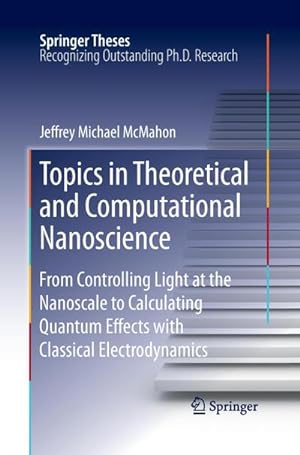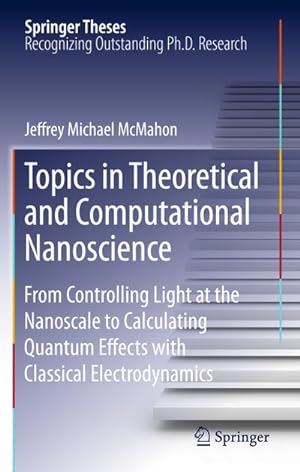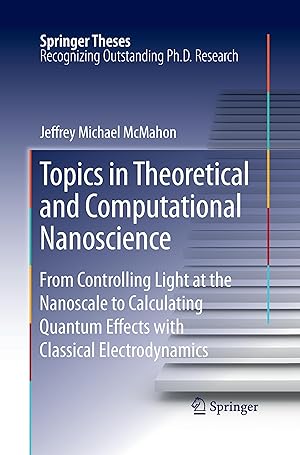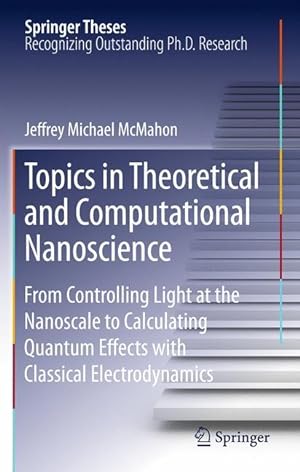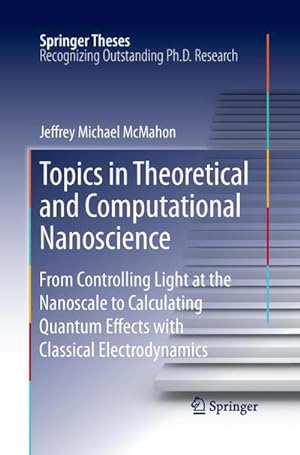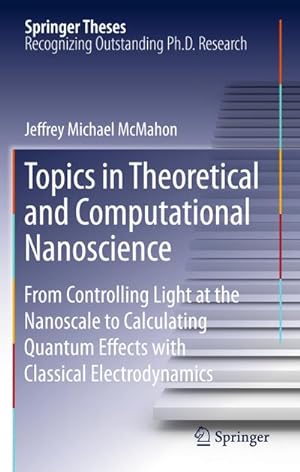topics theoretical computational nanoscience de mcmahon jeffrey (33 resultados)
Filtros de búsqueda
Tipo de artículo
- Todos los tipos de productos
- Libros (33)
- Revistas y publicaciones (No hay ningún otro resultado que coincida con este filtro.)
- Cómics (No hay ningún otro resultado que coincida con este filtro.)
- Partituras (No hay ningún otro resultado que coincida con este filtro.)
- Arte, grabados y pósters (No hay ningún otro resultado que coincida con este filtro.)
- Fotografías (No hay ningún otro resultado que coincida con este filtro.)
- Mapas (No hay ningún otro resultado que coincida con este filtro.)
- Manuscritos y coleccionismo de papel (No hay ningún otro resultado que coincida con este filtro.)
Condición Más información
- Nuevo (27)
- Como nuevo, Excelente o Muy bueno (5)
- Bueno o Aceptable (No hay ningún otro resultado que coincida con este filtro.)
- Regular o Pobre (No hay ningún otro resultado que coincida con este filtro.)
- Tal como se indica (1)
Encuadernación
Más atributos
- Primera edición (No hay ningún otro resultado que coincida con este filtro.)
- Firmado (No hay ningún otro resultado que coincida con este filtro.)
- Sobrecubierta (No hay ningún otro resultado que coincida con este filtro.)
- Con imágenes (14)
- No impresión bajo demanda (26)
Idioma (1)
Gastos de envío gratis
- Envío gratis a España (No hay ningún otro resultado que coincida con este filtro.)
Ubicación del vendedor
Valoración de los vendedores
-
Topics in Theoretical and Computational Nanoscience : From Controlling Light at the Nanoscale to Calculating Quantum Effects with Classical Electrodynamics
Librería: Buchpark, Trebbin, Alemania
EUR 75,64
Convertir monedaEUR 14,90 gastos de envío desde Alemania a EspañaCantidad disponible: 1 disponibles
Añadir al carritoCondición: Sehr gut. Zustand: Sehr gut | Sprache: Englisch | Produktart: Bücher.
-
Topics in Theoretical and Computational Nanoscience : From Controlling Light at the Nanoscale to Calculating Quantum Effects with Classical Electrodynamics
Librería: Buchpark, Trebbin, Alemania
EUR 75,64
Convertir monedaEUR 14,90 gastos de envío desde Alemania a EspañaCantidad disponible: 1 disponibles
Añadir al carritoCondición: Hervorragend. Zustand: Hervorragend | Sprache: Englisch | Produktart: Bücher.
-
Topics in Theoretical and Computational Nanoscience : From Controlling Light at the Nanoscale to Calculating Quantum Effects With Classical Electrodynamics
Librería: GreatBookPrices, Columbia, MD, Estados Unidos de America
EUR 102,58
Convertir monedaEUR 17,21 gastos de envío desde Estados Unidos de America a EspañaCantidad disponible: 15 disponibles
Añadir al carritoCondición: New.
-
Topics in Theoretical and Computational Nanoscience : From Controlling Light at the Nanoscale to Calculating Quantum Effects With Classical Electrodynamics
Librería: GreatBookPrices, Columbia, MD, Estados Unidos de America
EUR 102,62
Convertir monedaEUR 17,21 gastos de envío desde Estados Unidos de America a EspañaCantidad disponible: Más de 20 disponibles
Añadir al carritoCondición: New.
-
Topics in Theoretical and Computational Nanoscience: From Controlling Light at the Nanoscale to Calculating Quantum Effects with Classical Electrodynamics (Springer Theses)
Librería: Ria Christie Collections, Uxbridge, Reino Unido
EUR 115,57
Convertir monedaEUR 5,16 gastos de envío desde Reino Unido a EspañaCantidad disponible: Más de 20 disponibles
Añadir al carritoCondición: New. In.
-
Topics in Theoretical and Computational Nanoscience : From Controlling Light at the Nanoscale to Calculating Quantum Effects with Classical Electrodynamics
Publicado por Springer New York, Springer US, 2016
ISBN 10: 1493951874 ISBN 13: 9781493951871
Idioma: Inglés
Librería: AHA-BUCH GmbH, Einbeck, Alemania
EUR 111,35
Convertir monedaEUR 11,99 gastos de envío desde Alemania a EspañaCantidad disponible: 1 disponibles
Añadir al carritoTaschenbuch. Condición: Neu. Druck auf Anfrage Neuware - Printed after ordering - Interest in structures with nanometer-length features has significantly increased as experimental techniques for their fabrication have become possible. The study of phenomena in this area is termed nanoscience, and is a research focus of chemists, pure and applied physics, electrical engineers, and others. The reason for such a focus is the wide range of novel effects that exist at this scale, both of fundamental and practical interest, which often arise from the interaction between metallic nanostructures and light, and range from large electromagnetic field enhancements to extraordinary optical transmission of light through arrays of subwavelength holes.This dissertation is aimed at addressing some of the most fundamental and outstanding questions in nanoscience from a theoretical and computational perspective, specifically: At the single nanoparticle level, how well do experimental and classical electrodynamics agree What is the detailed relationship between optical response and nanoparticle morphology, composition, and environment Does an optimal nanostructure exist for generating large electromagnetic field enhancements, and is there a fundamental limit to this Can nanostructures be used to control light, such as confining it, or causing fundamentally different scattering phenomena to interact, such as electromagnetic surface modes and diffraction effects Is it possible to calculate quantum effects using classical electrodynamics, and if so, how do they affect optical properties.
-
Topics in Theoretical and Computational Nanoscience: From Controlling Light at the Nanoscale to Calculating Quantum Effects with Classical Electrodynamics (Springer Theses)
Librería: Ria Christie Collections, Uxbridge, Reino Unido
EUR 123,27
Convertir monedaEUR 5,16 gastos de envío desde Reino Unido a EspañaCantidad disponible: Más de 20 disponibles
Añadir al carritoCondición: New. In.
-
Topics in Theoretical and Computational Nanoscience : From Controlling Light at the Nanoscale to Calculating Quantum Effects with Classical Electrodyn
Librería: Chiron Media, Wallingford, Reino Unido
EUR 112,31
Convertir monedaEUR 17,23 gastos de envío desde Reino Unido a EspañaCantidad disponible: 10 disponibles
Añadir al carritoPF. Condición: New.
-
Topics in Theoretical and Computational Nanoscience : From Controlling Light at the Nanoscale to Calculating Quantum Effects with Classical Electrodynamics
Publicado por Springer New York, Springer US, 2011
ISBN 10: 1441982485 ISBN 13: 9781441982483
Idioma: Inglés
Librería: AHA-BUCH GmbH, Einbeck, Alemania
EUR 114,36
Convertir monedaEUR 11,99 gastos de envío desde Alemania a EspañaCantidad disponible: 1 disponibles
Añadir al carritoBuch. Condición: Neu. Druck auf Anfrage Neuware - Printed after ordering - Interest in structures with nanometer-length features has significantly increased as experimental techniques for their fabrication have become possible. The study of phenomena in this area is termed nanoscience, and is a research focus of chemists, pure and applied physics, electrical engineers, and others. The reason for such a focus is the wide range of novel effects that exist at this scale, both of fundamental and practical interest, which often arise from the interaction between metallic nanostructures and light, and range from large electromagnetic field enhancements to extraordinary optical transmission of light through arrays of subwavelength holes.This dissertation is aimed at addressing some of the most fundamental and outstanding questions in nanoscience from a theoretical and computational perspective, specifically: At the single nanoparticle level, how well do experimental and classical electrodynamics agree What is the detailed relationship between optical response and nanoparticle morphology, composition, and environment Does an optimal nanostructure exist for generating large electromagnetic field enhancements, and is there a fundamental limit to this Can nanostructures be used to control light, such as confining it, or causing fundamentally different scattering phenomena to interact, such as electromagnetic surface modes and diffraction effects Is it possible to calculate quantum effects using classical electrodynamics, and if so, how do they affect optical properties.
-
Topics in Theoretical and Computational Nanoscience : From Controlling Light at the Nanoscale to Calculating Quantum Effects With Classical Electrodynamics
Librería: GreatBookPricesUK, Woodford Green, Reino Unido
EUR 115,24
Convertir monedaEUR 17,24 gastos de envío desde Reino Unido a EspañaCantidad disponible: Más de 20 disponibles
Añadir al carritoCondición: New.
-
Topics in Theoretical and Computational Nanoscience: From Controlling Light at the Nanoscale to Calculating Quantum Effects with Classical Electrodyna
Librería: Kennys Bookshop and Art Galleries Ltd., Galway, GY, Irlanda
EUR 129,38
Convertir monedaEUR 2,00 gastos de envío desde Irlanda a EspañaCantidad disponible: 15 disponibles
Añadir al carritoCondición: New. 2016. Paperback. . . . . .
-
Topics in Theoretical and Computational Nanoscience : From Controlling Light at the Nanoscale to Calculating Quantum Effects With Classical Electrodynamics
Librería: GreatBookPrices, Columbia, MD, Estados Unidos de America
EUR 122,23
Convertir monedaEUR 17,21 gastos de envío desde Estados Unidos de America a EspañaCantidad disponible: 15 disponibles
Añadir al carritoCondición: As New. Unread book in perfect condition.
-
Topics in Theoretical and Computational Nanoscience
Publicado por Springer New York, Springer US Jun 2011, 2011
ISBN 10: 1441982485 ISBN 13: 9781441982483
Idioma: Inglés
Librería: buchversandmimpf2000, Emtmannsberg, BAYE, Alemania
EUR 106,99
Convertir monedaEUR 35,00 gastos de envío desde Alemania a EspañaCantidad disponible: 2 disponibles
Añadir al carritoBuch. Condición: Neu. Neuware -Interest in structures with nanometer-length features has significantly increased as experimental techniques for their fabrication have become possible. The study of phenomena in this area is termed nanoscience, and is a research focus of chemists, pure and applied physics, electrical engineers, and others. The reason for such a focus is the wide range of novel effects that exist at this scale, both of fundamental and practical interest, which often arise from the interaction between metallic nanostructures and light, and range from large electromagnetic field enhancements to extraordinary optical transmission of light through arrays of subwavelength holes.This dissertation is aimed at addressing some of the most fundamental and outstanding questions in nanoscience from a theoretical and computational perspective, specifically: At the single nanoparticle level, how well do experimental and classical electrodynamics agree What is the detailed relationship between optical response and nanoparticle morphology, composition, and environment Does an optimal nanostructure exist for generating large electromagnetic field enhancements, and is there a fundamental limit to this Can nanostructures be used to control light, such as confining it, or causing fundamentally different scattering phenomena to interact, such as electromagnetic surface modes and diffraction effects Is it possible to calculate quantum effects using classical electrodynamics, and if so, how do they affect optical properties Springer Verlag GmbH, Tiergartenstr. 17, 69121 Heidelberg 216 pp. Englisch.
-
Topics in Theoretical and Computational Nanoscience
Publicado por Springer New York, Springer US Aug 2016, 2016
ISBN 10: 1493951874 ISBN 13: 9781493951871
Idioma: Inglés
Librería: buchversandmimpf2000, Emtmannsberg, BAYE, Alemania
EUR 106,99
Convertir monedaEUR 35,00 gastos de envío desde Alemania a EspañaCantidad disponible: 2 disponibles
Añadir al carritoTaschenbuch. Condición: Neu. Neuware -Interest in structures with nanometer-length features has significantly increased as experimental techniques for their fabrication have become possible. The study of phenomena in this area is termed nanoscience, and is a research focus of chemists, pure and applied physics, electrical engineers, and others. The reason for such a focus is the wide range of novel effects that exist at this scale, both of fundamental and practical interest, which often arise from the interaction between metallic nanostructures and light, and range from large electromagnetic field enhancements to extraordinary optical transmission of light through arrays of subwavelength holes.This dissertation is aimed at addressing some of the most fundamental and outstanding questions in nanoscience from a theoretical and computational perspective, specifically: At the single nanoparticle level, how well do experimental and classical electrodynamics agree What is the detailed relationship between optical response and nanoparticle morphology, composition, and environment Does an optimal nanostructure exist for generating large electromagnetic field enhancements, and is there a fundamental limit to this Can nanostructures be used to control light, such as confining it, or causing fundamentally different scattering phenomena to interact, such as electromagnetic surface modes and diffraction effects Is it possible to calculate quantum effects using classical electrodynamics, and if so, how do they affect optical properties Springer Verlag GmbH, Tiergartenstr. 17, 69121 Heidelberg 216 pp. Englisch.
-
Topics in Theoretical and Computational Nanoscience: From Controlling Light at the Nanoscale to Calculating Quantum Effects with Classical Electrodyna
Librería: Kennys Bookstore, Olney, MD, Estados Unidos de America
EUR 160,81
Convertir monedaEUR 1,89 gastos de envío desde Estados Unidos de America a EspañaCantidad disponible: 15 disponibles
Añadir al carritoCondición: New. 2016. Paperback. . . . . . Books ship from the US and Ireland.
-
Topics in Theoretical and Computational Nanoscience: From Controlling Light at the Nanoscale to Calculating Quantum Effects With Classical Electrodynamics
Librería: Revaluation Books, Exeter, Reino Unido
EUR 152,85
Convertir monedaEUR 11,49 gastos de envío desde Reino Unido a EspañaCantidad disponible: 2 disponibles
Añadir al carritoHardcover. Condición: Brand New. 214 pages. 6.50x9.50x0.50 inches. In Stock.
-
Topics in Theoretical and Computational Nanoscience: From Controlling Light at the Nanoscale to Calculating Quantum Effects with Classical Electrodynamics (Springer Theses)
Librería: Lucky's Textbooks, Dallas, TX, Estados Unidos de America
EUR 102,89
Convertir monedaEUR 64,56 gastos de envío desde Estados Unidos de America a EspañaCantidad disponible: Más de 20 disponibles
Añadir al carritoCondición: New.
-
Topics in Theoretical and Computational Nanoscience: From Controlling Light at the Nanoscale to Calculating Quantum Effects with Classical Electrodynamics (Springer Theses)
Librería: Lucky's Textbooks, Dallas, TX, Estados Unidos de America
EUR 103,23
Convertir monedaEUR 64,56 gastos de envío desde Estados Unidos de America a EspañaCantidad disponible: Más de 20 disponibles
Añadir al carritoCondición: New.
-
Topics in Theoretical and Computational Nanoscience (Hardcover)
Publicado por Springer-Verlag New York Inc., New York, NY, 2011
ISBN 10: 1441982485 ISBN 13: 9781441982483
Idioma: Inglés
Librería: Grand Eagle Retail, Bensenville, IL, Estados Unidos de America
EUR 104,93
Convertir monedaEUR 64,56 gastos de envío desde Estados Unidos de America a EspañaCantidad disponible: 1 disponibles
Añadir al carritoHardcover. Condición: new. Hardcover. Interest in structures with nanometer-length features has significantly increased as experimental techniques for their fabrication have become possible. The study of phenomena in this area is termed nanoscience, and is a research focus of chemists, pure and applied physics, electrical engineers, and others. The reason for such a focus is the wide range of novel effects that exist at this scale, both of fundamental and practical interest, which often arise from the interaction between metallic nanostructures and light, and range from large electromagnetic field enhancements to extraordinary optical transmission of light through arrays of subwavelength holes.This dissertation is aimed at addressing some of the most fundamental and outstanding questions in nanoscience from a theoretical and computational perspective, specifically: At the single nanoparticle level, how well do experimental and classical electrodynamics agree? What is the detailed relationship between optical response and nanoparticle morphology, composition, and environment? Does an optimal nanostructure exist for generating large electromagnetic field enhancements, and is there a fundamental limit to this? Can nanostructures be used to control light, such as confining it, or causing fundamentally different scattering phenomena to interact, such as electromagnetic surface modes and diffraction effects? Is it possible to calculate quantum effects using classical electrodynamics, and if so, how do they affect optical properties? This book examines some of the most fundamental and outstanding questions in nanoscience from a theoretical computational perspective. It features interdisciplinary applications for chemistry, physics, and materials science. Shipping may be from multiple locations in the US or from the UK, depending on stock availability.
-
Topics in Theoretical and Computational Nanoscience (Paperback)
Publicado por Springer-Verlag New York Inc., New York, 2016
ISBN 10: 1493951874 ISBN 13: 9781493951871
Idioma: Inglés
Librería: Grand Eagle Retail, Bensenville, IL, Estados Unidos de America
EUR 104,97
Convertir monedaEUR 64,56 gastos de envío desde Estados Unidos de America a EspañaCantidad disponible: 1 disponibles
Añadir al carritoPaperback. Condición: new. Paperback. Interest in structures with nanometer-length features has significantly increased as experimental techniques for their fabrication have become possible. The study of phenomena in this area is termed nanoscience, and is a research focus of chemists, pure and applied physics, electrical engineers, and others. The reason for such a focus is the wide range of novel effects that exist at this scale, both of fundamental and practical interest, which often arise from the interaction between metallic nanostructures and light, and range from large electromagnetic field enhancements to extraordinary optical transmission of light through arrays of subwavelength holes.This dissertation is aimed at addressing some of the most fundamental and outstanding questions in nanoscience from a theoretical and computational perspective, specifically: At the single nanoparticle level, how well do experimental and classical electrodynamics agree? What is the detailed relationship between optical response and nanoparticle morphology, composition, and environment? Does an optimal nanostructure exist for generating large electromagnetic field enhancements, and is there a fundamental limit to this? Can nanostructures be used to control light, such as confining it, or causing fundamentally different scattering phenomena to interact, such as electromagnetic surface modes and diffraction effects? Is it possible to calculate quantum effects using classical electrodynamics, and if so, how do they affect optical properties? This book examines some of the most fundamental and outstanding questions in nanoscience from a theoretical computational perspective. It features interdisciplinary applications for chemistry, physics, and materials science. Shipping may be from multiple locations in the US or from the UK, depending on stock availability.
-
Topics in Theoretical and Computational Nanoscience : From Controlling Light at the Nanoscale to Calculating Quantum Effects With Classical Electrodynamics
Librería: GreatBookPricesUK, Woodford Green, Reino Unido
EUR 176,39
Convertir monedaEUR 17,24 gastos de envío desde Reino Unido a EspañaCantidad disponible: Más de 20 disponibles
Añadir al carritoCondición: As New. Unread book in perfect condition.
-
Topics in Theoretical and Computational Nanoscience: From Controlling Light at the Nanoscale to Calculating Quantum Effects with Classical Electrodynamics (Springer Theses)
Librería: Books Puddle, New York, NY, Estados Unidos de America
EUR 186,73
Convertir monedaEUR 9,90 gastos de envío desde Estados Unidos de America a EspañaCantidad disponible: 4 disponibles
Añadir al carritoCondición: New. pp. 214.
-
Topics in Theoretical and Computational Nanoscience: From Controlling Light at the Nanoscale to Calculating Quantum Effects with Classical Electrodynamics (Springer Theses)
Librería: Mispah books, Redhill, SURRE, Reino Unido
EUR 166,93
Convertir monedaEUR 28,74 gastos de envío desde Reino Unido a EspañaCantidad disponible: 1 disponibles
Añadir al carritoPaperback. Condición: Like New. Like New. book.
-
Topics in Theoretical and Computational Nanoscience : From Controlling Light at the Nanoscale to Calculating Quantum Effects With Classical Electrodynamics
Librería: GreatBookPrices, Columbia, MD, Estados Unidos de America
EUR 199,18
Convertir monedaEUR 17,21 gastos de envío desde Estados Unidos de America a EspañaCantidad disponible: Más de 20 disponibles
Añadir al carritoCondición: As New. Unread book in perfect condition.
-
Topics in Theoretical and Computational Nanoscience (Paperback)
Publicado por Springer-Verlag New York Inc., New York, 2016
ISBN 10: 1493951874 ISBN 13: 9781493951871
Idioma: Inglés
Librería: AussieBookSeller, Truganina, VIC, Australia
EUR 187,67
Convertir monedaEUR 31,85 gastos de envío desde Australia a EspañaCantidad disponible: 1 disponibles
Añadir al carritoPaperback. Condición: new. Paperback. Interest in structures with nanometer-length features has significantly increased as experimental techniques for their fabrication have become possible. The study of phenomena in this area is termed nanoscience, and is a research focus of chemists, pure and applied physics, electrical engineers, and others. The reason for such a focus is the wide range of novel effects that exist at this scale, both of fundamental and practical interest, which often arise from the interaction between metallic nanostructures and light, and range from large electromagnetic field enhancements to extraordinary optical transmission of light through arrays of subwavelength holes.This dissertation is aimed at addressing some of the most fundamental and outstanding questions in nanoscience from a theoretical and computational perspective, specifically: At the single nanoparticle level, how well do experimental and classical electrodynamics agree? What is the detailed relationship between optical response and nanoparticle morphology, composition, and environment? Does an optimal nanostructure exist for generating large electromagnetic field enhancements, and is there a fundamental limit to this? Can nanostructures be used to control light, such as confining it, or causing fundamentally different scattering phenomena to interact, such as electromagnetic surface modes and diffraction effects? Is it possible to calculate quantum effects using classical electrodynamics, and if so, how do they affect optical properties? This book examines some of the most fundamental and outstanding questions in nanoscience from a theoretical computational perspective. It features interdisciplinary applications for chemistry, physics, and materials science. Shipping may be from our Sydney, NSW warehouse or from our UK or US warehouse, depending on stock availability.
-
Topics in Theoretical and Computational Nanoscience (Hardcover)
Publicado por Springer-Verlag New York Inc., New York, NY, 2011
ISBN 10: 1441982485 ISBN 13: 9781441982483
Idioma: Inglés
Librería: AussieBookSeller, Truganina, VIC, Australia
EUR 188,51
Convertir monedaEUR 31,85 gastos de envío desde Australia a EspañaCantidad disponible: 1 disponibles
Añadir al carritoHardcover. Condición: new. Hardcover. Interest in structures with nanometer-length features has significantly increased as experimental techniques for their fabrication have become possible. The study of phenomena in this area is termed nanoscience, and is a research focus of chemists, pure and applied physics, electrical engineers, and others. The reason for such a focus is the wide range of novel effects that exist at this scale, both of fundamental and practical interest, which often arise from the interaction between metallic nanostructures and light, and range from large electromagnetic field enhancements to extraordinary optical transmission of light through arrays of subwavelength holes.This dissertation is aimed at addressing some of the most fundamental and outstanding questions in nanoscience from a theoretical and computational perspective, specifically: At the single nanoparticle level, how well do experimental and classical electrodynamics agree? What is the detailed relationship between optical response and nanoparticle morphology, composition, and environment? Does an optimal nanostructure exist for generating large electromagnetic field enhancements, and is there a fundamental limit to this? Can nanostructures be used to control light, such as confining it, or causing fundamentally different scattering phenomena to interact, such as electromagnetic surface modes and diffraction effects? Is it possible to calculate quantum effects using classical electrodynamics, and if so, how do they affect optical properties? This book examines some of the most fundamental and outstanding questions in nanoscience from a theoretical computational perspective. It features interdisciplinary applications for chemistry, physics, and materials science. Shipping may be from our Sydney, NSW warehouse or from our UK or US warehouse, depending on stock availability.
-
Topics in Theoretical and Computational Nanoscience
Librería: moluna, Greven, Alemania
EUR 92,27
Convertir monedaEUR 19,49 gastos de envío desde Alemania a EspañaCantidad disponible: Más de 20 disponibles
Añadir al carritoCondición: New. Dieser Artikel ist ein Print on Demand Artikel und wird nach Ihrer Bestellung fuer Sie gedruckt. - Prize-awarded thesis - New research in an emerging field - Interdisciplinary applications for chemistry, physics, and materials scienceInterest in structures with nanometer-length features has significantly increased as experimental techniques for .
-
Topics in Theoretical and Computational Nanoscience
Librería: moluna, Greven, Alemania
EUR 92,27
Convertir monedaEUR 19,49 gastos de envío desde Alemania a EspañaCantidad disponible: Más de 20 disponibles
Añadir al carritoGebunden. Condición: New. Dieser Artikel ist ein Print on Demand Artikel und wird nach Ihrer Bestellung fuer Sie gedruckt. - Prize-awarded thesis - New research in an emerging field - Interdisciplinary applications for chemistry, physics, and materials scienceInterest in structures with nanometer-length features has significantly increased as experimental techniques for .
-
Topics in Theoretical and Computational Nanoscience
Publicado por Springer New York Aug 2016, 2016
ISBN 10: 1493951874 ISBN 13: 9781493951871
Idioma: Inglés
Librería: BuchWeltWeit Ludwig Meier e.K., Bergisch Gladbach, Alemania
EUR 106,99
Convertir monedaEUR 11,00 gastos de envío desde Alemania a EspañaCantidad disponible: 2 disponibles
Añadir al carritoTaschenbuch. Condición: Neu. This item is printed on demand - it takes 3-4 days longer - Neuware -Interest in structures with nanometer-length features has significantly increased as experimental techniques for their fabrication have become possible. The study of phenomena in this area is termed nanoscience, and is a research focus of chemists, pure and applied physics, electrical engineers, and others. The reason for such a focus is the wide range of novel effects that exist at this scale, both of fundamental and practical interest, which often arise from the interaction between metallic nanostructures and light, and range from large electromagnetic field enhancements to extraordinary optical transmission of light through arrays of subwavelength holes.This dissertation is aimed at addressing some of the most fundamental and outstanding questions in nanoscience from a theoretical and computational perspective, specifically: At the single nanoparticle level, how well do experimental and classical electrodynamics agree What is the detailed relationship between optical response and nanoparticle morphology, composition, and environment Does an optimal nanostructure exist for generating large electromagnetic field enhancements, and is there a fundamental limit to this Can nanostructures be used to control light, such as confining it, or causing fundamentally different scattering phenomena to interact, such as electromagnetic surface modes and diffraction effects Is it possible to calculate quantum effects using classical electrodynamics, and if so, how do they affect optical properties 216 pp. Englisch.
-
Topics in Theoretical and Computational Nanoscience
Publicado por Springer New York Jun 2011, 2011
ISBN 10: 1441982485 ISBN 13: 9781441982483
Idioma: Inglés
Librería: BuchWeltWeit Ludwig Meier e.K., Bergisch Gladbach, Alemania
EUR 106,99
Convertir monedaEUR 11,00 gastos de envío desde Alemania a EspañaCantidad disponible: 2 disponibles
Añadir al carritoBuch. Condición: Neu. This item is printed on demand - it takes 3-4 days longer - Neuware -Interest in structures with nanometer-length features has significantly increased as experimental techniques for their fabrication have become possible. The study of phenomena in this area is termed nanoscience, and is a research focus of chemists, pure and applied physics, electrical engineers, and others. The reason for such a focus is the wide range of novel effects that exist at this scale, both of fundamental and practical interest, which often arise from the interaction between metallic nanostructures and light, and range from large electromagnetic field enhancements to extraordinary optical transmission of light through arrays of subwavelength holes.This dissertation is aimed at addressing some of the most fundamental and outstanding questions in nanoscience from a theoretical and computational perspective, specifically: At the single nanoparticle level, how well do experimental and classical electrodynamics agree What is the detailed relationship between optical response and nanoparticle morphology, composition, and environment Does an optimal nanostructure exist for generating large electromagnetic field enhancements, and is there a fundamental limit to this Can nanostructures be used to control light, such as confining it, or causing fundamentally different scattering phenomena to interact, such as electromagnetic surface modes and diffraction effects Is it possible to calculate quantum effects using classical electrodynamics, and if so, how do they affect optical properties 216 pp. Englisch.






